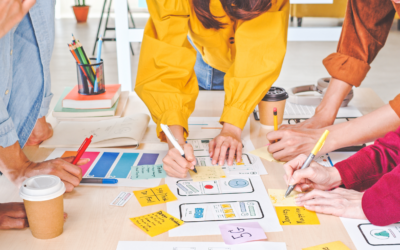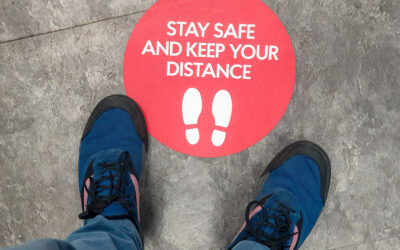Table of Content
- Introduction
- Skills for a User Experience Perspective
- Skills for a User Experience Perspective
- Other Important Skills
Introduction
We hear a lot about the role of UI/UX design these days. With the continued growth of technology, the need for functional and aesthetic products in digital platforms is increasing. So, we designers may see a lot of new businesses and companies requiring our services. These roles may appear in different specializations, such as UX design, UI design, UX research, UI research, etc. Are you thinking of joining us?
In this post, we’ll discuss several important aspects of various UI and UX design roles as well as 11 skills necessary to fulfill these roles within the industry.
Skills for a User Experience Perspective
1. User-Centered Mindset
A UI/UX designer must always have the user in mind while proposing design solutions. A user-centered mindset also means having the correct and most valuable information needed to achieve the development of a successful product…and, of course, the vast majority of useful information comes from accurate and in-depth user research.
The UI/UX designer must attack the topic of user research from several different perspectives:
Demographic: Based on market research, identify the everyday life aspects of your users for demographic information such as age, gender, socioeconomics, lifestyle, habits, etc.
Product-specific: Through qualitative research with interviews, focus groups, or surveys, UI/UX designers must discover what users think of and expect from the product.
Personas: After user commonalities are identified, designers must establish user examples, or profiles, to guide their journey.
2. Usability Testing and Data Analysis
Usability testing is also an important part of user research. UI/UX designers must have the opportunity to submit potential products to be tested with real users so meaningful user feedback can be gathered and evaluated.
While performing these tests, UI/UX designers must utilize another set of important skills:
Prototyping: For product testing, UI/UX designers need to be able to incorporate the essential information and graphics into a functional prototype.
Observation: UI/UX designers must have the ability to see beyond the user in order to observe and detect crucial but less-obvious details.
Ask and listen: To gather meaningful feedback, UI/UX designers must be prepared to ask the right questions and provide the opportunity for users to voice and explain their answers.
Analysis: UI/UX designers must be able to cross-tabulate data from technical requirements and usability testing results in order to develop and propose a winning solution.
UI/UX designers must be constantly testing their designs and submitting them for continuous feedback gathering, learning, and improvement.
3. Navigation Architecture Analysis
Navigation architecture analysis refers to the ability to understand a product’s needs, business goals, and users’ needs, and then translate this knowledge into a successful navigation architecture and user experience.
A UI/UX designer must study technical requirements and meet with product owners and other key stakeholders to fully comprehend a product’s functionality. In short, navigation architecture requires a broad and thorough vision of what a product needs to accomplish.
UI/UX designers must also consider the platform or platforms where a product is going to live. These platforms already have users, so the navigation needs to work within already-established and known patterns.
In the end, if users can perform the product’s desired actions without issues, and all technical functionality is present, then UI/UX designers can confirm that they are providing good navigation architecture.
Skills for a User Interface Perspective
4. Visuals and Graphics
UI/UX designers will also encounter the task of creating visuals for web or mobile applications. Often these visuals will require specific abilities:
Icon-type: Icon-type graphics require perfection from a pixel-perfect point of view. Icon-type images also need excellent graphic communication and graphic synthesis since they live in a limited space.
Illustration-type: Illustration-type graphics require other graphics skills since they are created from more of a design perspective, due to the detail needed. Illustrations in UI/UX products need to capture the user’s attention, be aesthetically pleasing, and accomplish a communicative objective.
5. Layout/Editorial Design
Most user interface work is about the layout of the screen and the placement of graphics and objects.
When we think of editorial, our minds typically go directly to printed products like magazines or books, but editorial design is necessary in UI/UX design too.
Several aspects of traditional editorial design also contribute to UI/UX and are essential for a designer to manage:
Layout planning: This refers to the need to break up the screen and plan design space into functional areas.
Object placing: Interfaces require the placement of specific amounts of information and graphics while still accomplishing the goals of being readable, communicative, and useful.
Font and color: Font styles and colors are other aspects that impact interface functionality. If the font or the colorimetry are not on the spot, it will interfere with the experience of the product.
Other Important Skills
6. Communication
We know that the primary goal of any design is to effectively communicate an idea or concept through graphics, spaces, and objects. So, by definition, every designer must possess good communication skills.
Effective communication involves a number of different angles:
- Communicating ideas among team and customers
- Communicating concepts through graphics
- Communicating functionality through documentation
Often, it is the role of the designer to explain and convey various complex or abstract concepts. In order for stakeholders (developers, testers, etc.) to best understand and be most willing to implement ideas, designers may prefer working with products that require more straightforward explanations and documentation.
7. Collaboration
The UI/UX designer’s job is always collaborative. We collaborate with other designers, developers, testers, product owners, project managers, customers, and users, among others.
In the design process, we often encounter questions about technical viability, at which time developers can jump in to help provide feedback and suggestions. Designers must be open to this type of collaboration with other departments. A design will never reach its final users if it is not technically viable for implementation.
Designers also need to be open to receiving product requirements and other critical information from product owners and managers.
8. Creativity
“Creativity” is undoubtedly one of the words we hear most frequently when talking about design. We define it as the creation of new or original solutions. In UI/UX design, however, it’s important to understand that creativity won’t always mean new, because users already interact with established patterns and behaviors. Bringing the “new factor” to a design could result in users not recognizing the interface and, thus, giving poor usability feedback. Therefore, creativity in UI/UX means searching for and implementing alternative and different solutions within the range of the user’s knowledge and understanding.
A creative solution in UI/UX is one that presents a functional solution supported in design patterns and user behavior. An innovative solution is always user-centered while bringing “the wow factor.” In fact, users themselves will often identify original solutions for products that satisfy their needs and deliver a different experience.
9. Organization
As part of a team working on developing Web and Mobile Applications, you will interact with numerous files and significant amounts of documentation, such as requirements, parameter datasheets, branding documentation, and more. It’s important to organize all the files you receive from customers and other stakeholders as well as to track versions when you receive changes.
As a designer, you will also generate design files, presentations, and assets to share with your customer. We recommend tracking your files by date delivered or presented and implementing version control.
From the perspective of tracking change, meeting notes are also essential. In your records, try to specify meeting attendees, all requests, and who made them. Sometimes notetaking may not be possible, especially if you are presenting; if that’s the case, ask someone else on the team to help you take notes. Afterward, it’s wise to share your notes with the rest of the team so that everyone is on board with the customer’s requests.
10. Presentation
Standing in front of customers and presenting design ideas is, perhaps, the one requirement of the role that designers hate most. This dislike of standing and speaking in front of customers is often related to an individual designer’s personality—as well as the lack of experience interacting with customers directly.
The designer’s role in making presentations requires yet another set of skills:
- Language domination (for cases in which you are presenting in a non-native language)
- A clear idea of your plan and goals for the meeting
- Clarity while explaining ideas and details
- Empathy for the thoughts, feelings, and ideas of others
- Receptivity to critique
Presenting a design is not just explaining it—presenting is successfully selling an idea based on methodology and conceptualization. From experience, any seasoned designer will assure you that there is no perfect presentation. But there are many presentations which result in meaningful feedback, and that’s where the designer should focus…on the input.
11. A Love for Learning
Technology, devices, design software, tendencies, etc.—everything that makes up the design world is fast-moving. Successful UI/UX designers must have an insatiable curiosity and the ongoing desire to further their education and always be up-to-date with the latest information.
UI/UX designers consult numerous platforms for continuing education. Some examples include:
- Courses such as Coursera, Udemy, Udacity, etc.
- Industry-related blog posts
- YouTube channels and videos
Well, that’s a wrap!
We could fill the list of required skills for successful UI/UX designers to infinity and beyond. In addition, depending on the particular role or position in question, other design companies could add their own lengthy list of desired abilities and skills. Overall, however, we hope this post gives you a more solid understanding of the industry’s most-desired skills for UI/UX designers. Best wishes on your career path!












0 Comments